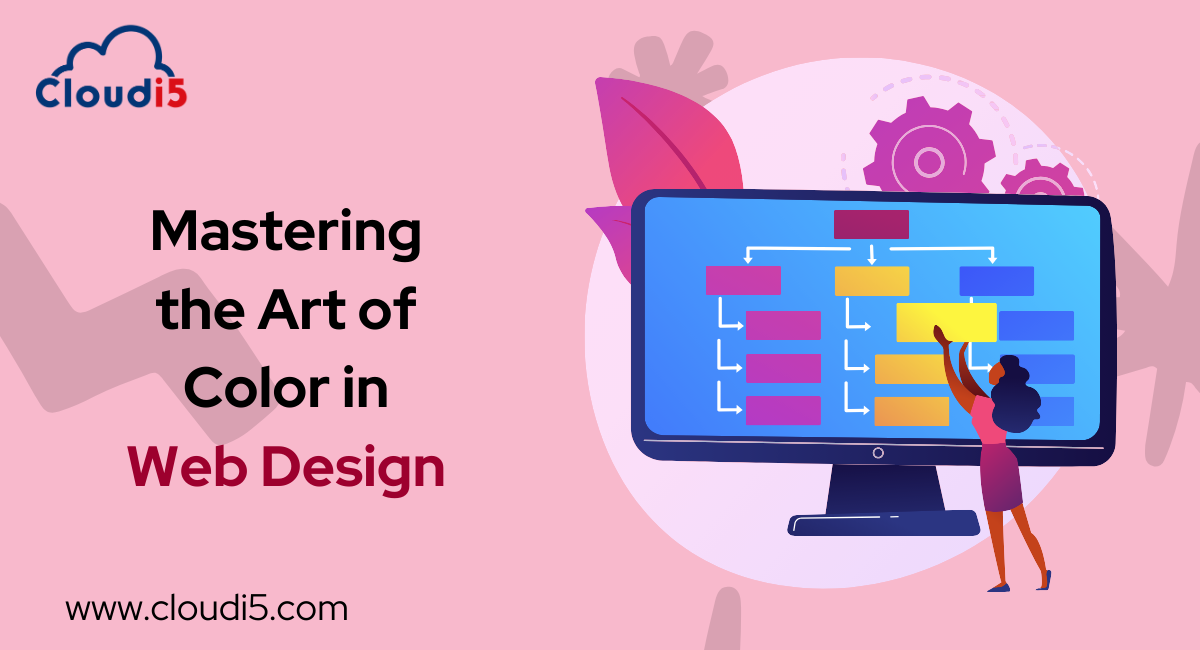
Mastering The Art Of Colour In Web Design: Tips And Best Practices
A well-designed website can be compared to a piece of art on the expansive internet. The success of a website also depends on how well it uses colour, just as a great painting needs the ideal combination of colours to express its message. Enjoy your journey through "Mastering the Art of Color in Web Design: Tips and Best Practices."
In the online world, colours are the silent storytellers. They can elicit feelings, deliver messages, and direct people through the digital world. Colours can impact user experience, increase conversion rates, and make a lasting impression when applied correctly. We'll get deep into the field of web design in this blog, where colour is a critical component that could decide the fate of a website, not just an aesthetic one.
Colour Psychology:
Colour is a particularly effective means of conveying feelings, establishing mood, and affecting user behaviour. This is where web design's use of colour psychology comes into play. It's the art and science of getting people to react and feel a sure way to a website through colour.
Why Is Colour Important for Web Design?
First impressions in the digital sphere happen in a couple of seconds. Users' perceptions of your brand or content may change instantly depending on the colours you choose for your website.
Emotional triggers: Colors can elicit strong feelings. Cool colours like blue and green can foster a sense of peace and trust, while warm hues like red and orange can arouse passion or enthusiasm.
User Engagement: User's interactions with websites can be influenced by colour and directed by colour. Crucial text or a call-to-action button can be highlighted with the proper placement of contrasting hues.
Readability and Accessibility: Making sure your website is accessible to all users, including those with visual impairments, and that the text is easily readable depends on your colour choices.
Common Colour Associations:
Although everyone responds to colour differently, several universal connections are frequently utilized in web design:
Red: Urgency, enthusiasm, passion, and energy. It's often used for CTA buttons.
Blue: Professionalism, calmness, and trust. It is a well-liked option for business websites.
Green: Growth, Nature, and Health. Frequently found in websites that promote wellness and the environment.
Yellow: Joy, optimism, and coziness. They are used to draw focus and draw attention to important details.
Orange: Enthusiasm, creativity, and exploration. They are frequently utilized for CTA buttons and brand elements.
Purple: Originality, elegance, and luxury. It is associated with luxury and artistic brands.
Black: Power, expertise, and elegance. Often seen on upscale and fashionable websites.
White: Cleanliness, simplicity, and purity. A popular option for simple layouts.
In conclusion, colour psychology is crucial for web designers to create website designs. Understanding colour psychology in web design is a strong tool to make your website visually appealing, emotionally resonant, and user-friendly in today's fast-paced digital environment.
Colour Harmony:
The subtle technique of arranging colours to create a mood or message in addition to being aesthetically pleasing is known as colour harmony. A suitable colour scheme must be created for a website to be both aesthetically pleasing and easy to use.
The colour wheel:
One essential tool for comprehending colour relationships is the colour wheel. It has three colours: tertiary colours, which are a combination of primary and secondary colours, orange, green, and purple, and primary colours, which are red, blue, and yellow.
- Primary colours: They are the building blocks of the colour wheel and cannot be made by combining numerous colours. The three fundamental web design colours are yellow, blue, and red. All other colours are built upon these foundational hues.
- Secondary colours: They are the building blocks of the colour wheel and cannot be made by combining numerous colours. The three fundamental web design colours are yellow, blue, and red. All other colours are built upon these foundational hues.
- Tertiary Colors: A primary colour combined with a nearby secondary colour produces tertiary colours. On the colour wheel, they are situated between primary and secondary hues. Blue-purple, yellow-green, and red-orange are tertiary colour examples.
Comprehending the colour wheel facilitates web designers in making well-informed decisions regarding colour schemes, guaranteeing that the selected colours evoke the intended tone and message.
Readability and Contrast:
Readability and contrast are essential components of web design that directly affect how users view and engage with a website. Fundamentally, readability refers to how simple it is for visitors to interact with and understand the content on a web page. It's essential to ensure users can easily take in information, improving their experience in general.
Contrarily, contrast is how different visual characteristics—like colour, brightness, and size—interplay to highlight and draw attention to particular parts.
Web designers create an environment where information is not only freely accessible but also simply consumable through the harmonic combination of contrast and readability. These components improve a website's appearance and serve as the foundations for user interaction, efficient communication, and a satisfying online experience for all users.
Branding and Consistency:
What makes an excellent Web Design? A well-designed website should engage visitors while fulfilling its intended purpose of communicating a certain message. Excellent website design is influenced by several elements, including usefulness, simplicity, graphics, typography, colours, and consistency, but the main factor is Colours, which immediately attract Users. Colour selections in web design are essential for communicating a brand's identity and guaranteeing a UX design. Colour is a big part of how an organization's beliefs and mission are represented visually, known as branding.
Colour elicits feelings and promotes instant recognition; examples are the bright and energizing reds of a youth-focused brand and the serene blues of a reliable financial institution. However, consistency is an essential requirement for the effectiveness of colour branding. An identifiable and memorable visual identity is created by ensuring that the selected colours are used consistently throughout the website.
In web design, integrating branding and colour consistency is more than just a matter of taste; it's a calculated move that affects user perception, builds user trust, and effectively communicates a brand's core.
Responsive Design:
Responsive design is the keystone of modern user interface (UI) design for web applications and websites. It's a design strategy that makes websites responsive and operates well across various screen sizes and devices. The term "responsive design" refers to the understanding that people visit websites from various devices, including desktop computers, tablets, smartphones, and other gadgets.
In Web Design Company, Web designers ensure the user experience is uniform and flawless across all devices by building responsive websites. Features like movable layouts, repositionable photos, and flexible typography enhance a responsive site's user-friendliness.
Receptive design is a fundamental component of a user-focused, accessible, and successful online presence in a world where people are always on the go and interacting with content on a growing number of devices.
Tools and Resources:
Numerous web design tools and resources are available to assist you in choosing, organizing, and using colour efficiently when it comes to site design. Here are some essential Web design tools and resources for helping you choose web design colour.
Adobe Color Wheel- You may build, explore, and save colour palettes using Adobe's colour wheel. There are also colour harmony criteria and options for exporting colour codes.
Coolors- Coolors is an intuitive colour scheme generator that only requires one button click to produce colour palettes.
Colour Hunt- Browse through Colour Hunt's carefully chosen selection of lovely colour schemes for your web design projects.
Adobe Color CC- This program, formerly known as Adobe Kuler, lets you extract colours from photographs, explore trending colour palettes, and build custom colour themes.
ColorHexa- All the information you need about colours, including their harmonies and conversions, may be found in ColorHexa.
These materials and web design tools cover various topics related to using colour in online design, including creating colour schemes, ensuring websites are accessible, and identifying specific colour values.
User Experience Design Courses:
Web designers who want to improve their ability to create visually appealing and user-friendly websites may find great value in taking User Experience design courses emphasizing colour theory and its application in web design.
The following are some courses that you may find helpful:
- Interaction Design Foundation
- LinkedIn Learning- UX and Web Design Courses
- Udemy- User Experience (UX) Design Courses
- Skillshare- Web Design and UX Courses
- Coursera- Google UX Design Certificate
To ensure the course fits your learning goals and tastes, check the course materials, instructor credentials, and user reviews. In addition, think about how you want to improve your knowledge of colour theory and its application to web design, as well as your UX design abilities, by taking a single course or enrolling in an extensive program.
Conclusion:
The ability to control colour is a crucial talent in the always-changing field of web design. Effective communication and user engagement depend heavily on understanding the psychological effects and cultural quirks of colour. Colour selections are strategic instruments for generating feelings, drawing attention, and creating brand identification, as shown by this exploration of the art of colour in web design.
Trusted By












Leave Comments